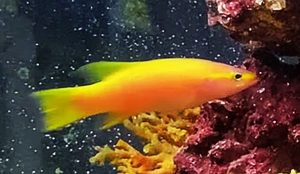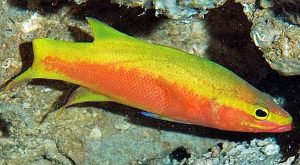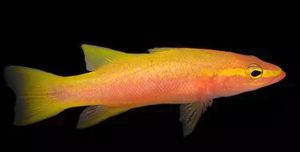The Golden Basslet (Liopropoma abberans) known to tropical fish keeping enthusiasts as the Eye-Stripe Basslet is found in extremely deep waters from Curacao to North Carolina.
Although the Golden Basslet occurs in the Gulf of Mexico to the South Caribbean, it lives at extreme depths making it just barely out of reach of Florida and other Atlantic fish collectors. Their range includes The Bahamas, the Caribbean, USA, Belize, Cuba, Curacao, Gulf of Mexico, Jamaica, Lesser Antilles, and the West-Atlantic Ocean.
The Golden Basslet has a compressed, pointed head with a moderately elongated body, and a rather large mouth with a slightly protruding lower jaw. The split spinous dorsal fins, pectoral, anal, and slightly forked caudal fins are all pointed.
The Golden Basslet has small rough scales over its body, and colors that are unbelievably vibrant. They have a rosy orange to salmon colored head and mid body, with a bright yellow stripe that runs from the snout, through the center of the black eye to the corner of the operculum. The lower two thirds of the body is salmon colored and the upper third is either yellow or salmon colored with dense yellow blotches. The pectoral fins are clear, and the dorsal, anal, pelvic, and anal fins are yellow. The yellow caudal fin has a large reddish brown blotch in its center, and is bordered by white.
Juvenile Eye-Stripe Basslets are completely yellow with just a faint orange glow on their bellies. As they mature their yellow underbody morphs into the beautiful orangish red color of adults.
The Golden Basslet (Liopropoma abberans) is similar to the Wrasse Basslet (Liopropoma eukrines) andCave Basslet (Liopropoma mowbrayi).
Like many other deep water basslets, the Golden Basslet is a shy, solitary species that is normally found alone or in widely spaced groups in small caves or holding next to solitary rocks where they can ambush their prey at extreme depths from 450 to over 800 feet.
Golden Basslets seem to prefer areas around sandy slopes or near little piles of rubble where they are almost always found waiting in ambush hidden behind the rocks. In some areas, two or three individuals are encountered in the same general area, but they are always at a distance of at least 10 to 15 feet apart from each other.
The Golden Basslet is best housed in a mature, deep water FOWLR or reef aquarium with a fine crushed coral substrate and copious amounts of live rock arranged into caves, nooks, overhangs, and plenty of live Mysis shrimp or other live foods for them to eat. Although they are considered reef safe with corals, they will eat decorative shrimp and crabs. Because of the extreme depths they are collected from, they require low, dim lighting conditions, cool water temperatures, and pristine water quality for them to thrive. Golden Basslets will benefit from cooler temperatures in the 60-68 degree range, but over time can be acclimated to temperatures in the low to mid 70s.
A chiller system is mandatory as is a good reef filtration system
. Once successfully acclimated, this species is incredibly adapted to captivity and can live a very long time with proper care.
The Golden Basslet has not been bred in an aquarium environment and little is known about their breeding habits.
In their natural deep water environment, Liopropoma abberans are aggressive hunters that feed on just about anything that moves. In an aquarium environment, they require plenty of live or frozen meaty foods to thrive, however, getting them to eat is never an issue. Golden Basslets definitely have an appetite and will generally eat almost anything you feed them. Large pieces of fish, krill, Mysis shrimp, fresh cut shrimp, and even carnivore flakes will be accepted.
The Golden Basslet (Liopropoma abberans) is one of the rarest, most beautiful fish ever brought up from the depths and despite its five figure selling price, is available to tropical fish keeping enthusiasts on a special order basis with a 1 to 2 month lead time, from a few specialty rare fish retailers, however, there are some things you need to know before you shell out the cash for this rare species.
In addition to being difficult to catch, Golden Basslets are most often found at depths between 350 and 800 feet. The majority of specimens that have been collected are with deep water submersibles between 350 to 500 feet, which is way over the limits of scuba divers and well beyond the limit of most rebreather divers.
Normally, most deep water Mesophotic zone fish are collected by rebreather divers and placed into a pressurized chamber where the pressure is slowly bled off over the course of a few days, but because these fish are caught with a submarine, putting them into a small pressure chamber to decompress is not feasible.
Instead, the fish are slowly brought up to a shallow enough depth by the submersible where divers can then decompress them. This means that every day for about a week, the fish are brought closer and closer to the surface where they are “pinned” to relieve the gas buildup in their expanded swim bladders. As they reach a shallower depth, the rate of ascent must be even slower until the atmospheric pressure is at sea level. The last 100 feet is where is where severe damage to the fish usually occurs. For this reason Golden Basslets and other extremely deep water species are often plagued with decompression and bacterial problems caused by improper “pinning”.
Assuming that your retailer has a healthy Golden Basslet that has successfully survived collection, be prepared to part with anywhere from $7,500.00 – $9,000.00.
Minimum Tank Size: 75 gallons
Aquarium Type: Reef or FOLR
Care Level: Moderate
Temperament: Semi Aggressive
Aquarium Hardiness: Hardy once acclimated
Water Conditions: 68 °F, dKH 8 – 12°, pH 8.1 – 8.2, sg 1.023-1.025
Max size: 5.31″
Color Form: Orange, Yellow
Diet: Carnivore
Compatibility: Reef with Caution
Origin: Western Central Atlantic, Cuba.
Family: Serranidae
Lifespan: 6 +years
Aquarist Experience Level: Expert





